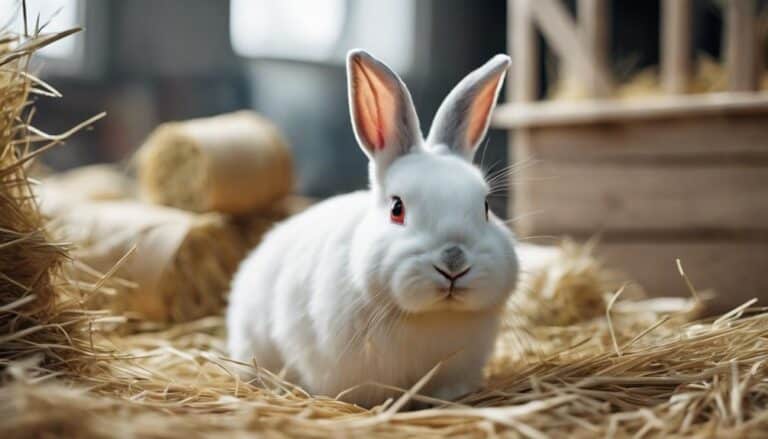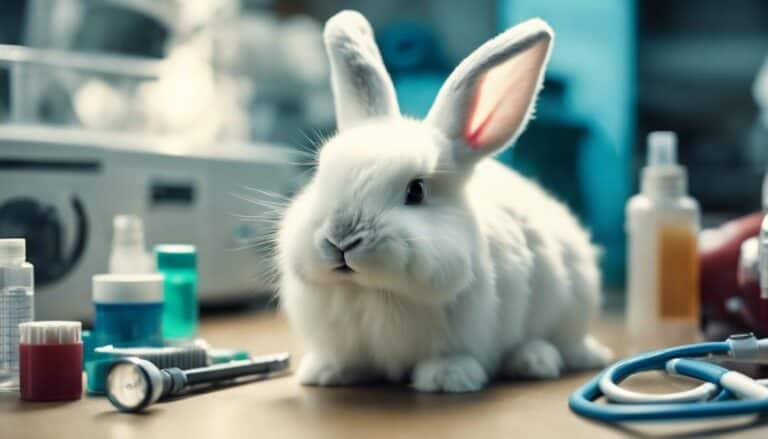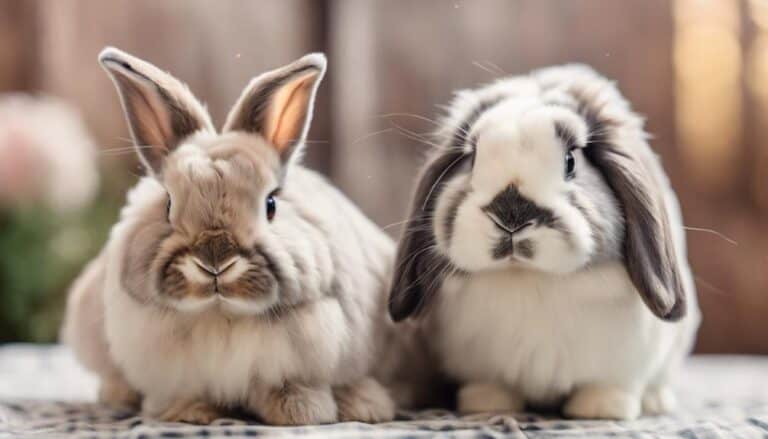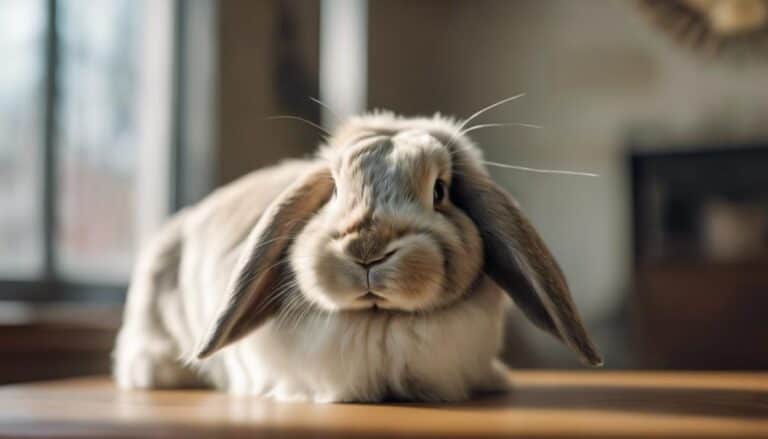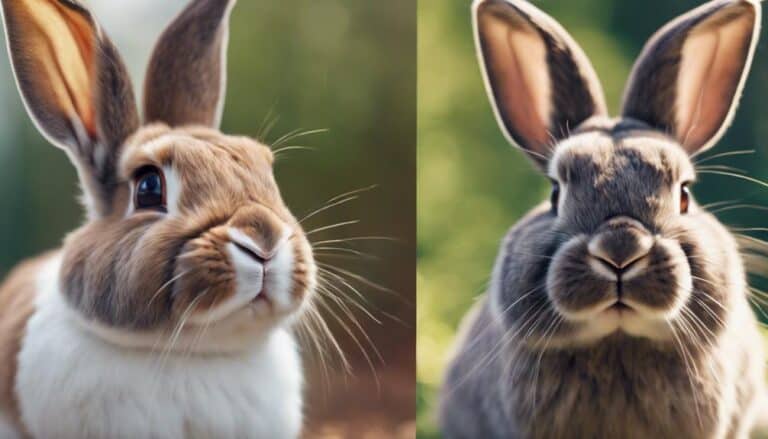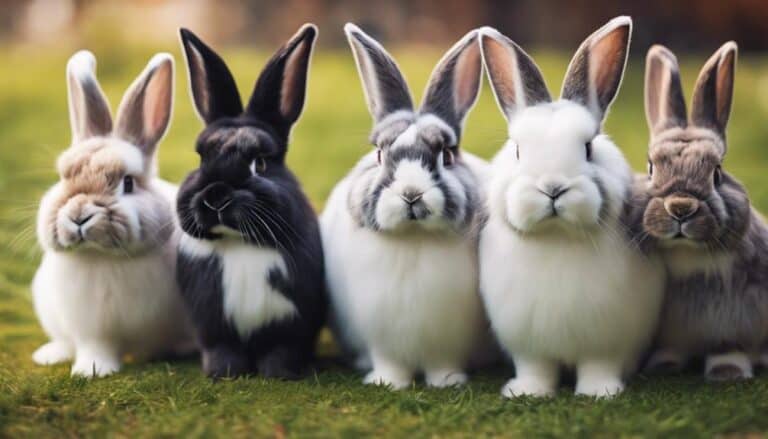Plunge into the world of Alaskan bunnies! Witness their hopping, observe their joyful expressions. Take note of how they mark territory, communicate with grunts and thumps. Comprehend why they grind their teeth. Observe how they engage with humans, nipping playfully. Witness their spraying behaviors. It's a captivating world waiting to be further investigated.
Contents
- 1 Key Takeaways
- 2 Bunny Hopping and Dancing Patterns
- 3 Territorial Chinning Habits of Bunnies
- 4 Vocalizations: Grunting and Thumping
- 5 Understanding Teeth Grinding in Bunnies
- 6 Circulating Behavior Around Humans
- 7 Playful Interactions and Nipping
- 8 Territory Marking and Spraying Behaviors
- 9 Are Alaskan Bunny Behavior Patterns Different from Common Bunny Behaviors?
- 10 Conclusion
Key Takeaways
- Bunny behavior patterns include hopping, dancing, and vocalizations.
- Territorial chinning habits establish boundaries and social dynamics.
- Understanding teeth grinding is crucial for overall well-being.
- Circulating behavior around humans reflects affection and social interaction.
- Bonding rituals like circling signify trust and desire for closeness with humans.
Bunny Hopping and Dancing Patterns
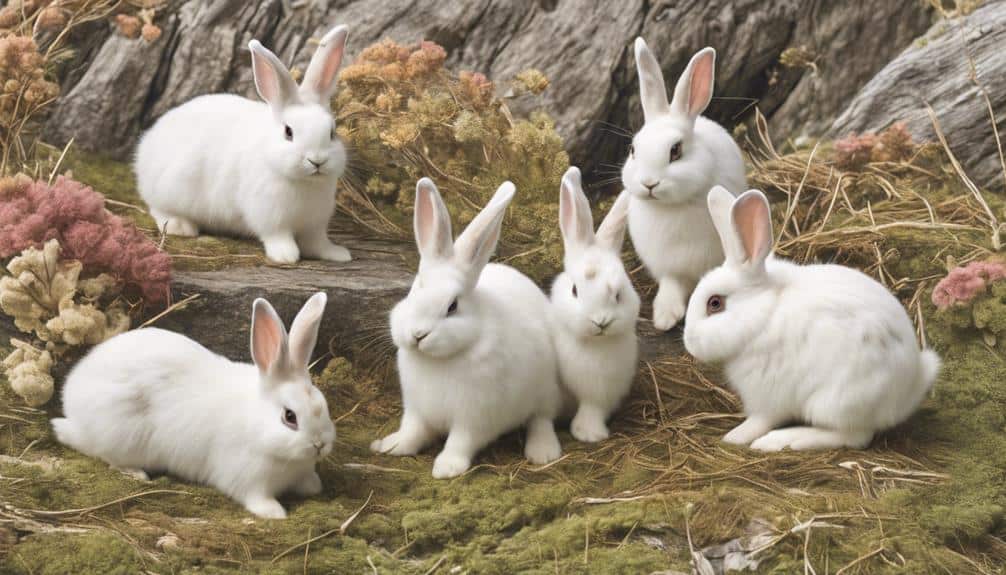
When observing Alaskan bunnies, their hopping and dancing patterns serve as vital indicators of their emotional state and overall well-being. The joy and happiness of these creatures are often displayed through their frequent hopping and graceful dancing movements. This behavior usually occurs when they're excited, content, or trying to communicate their feelings.
The variation in their hopping patterns can be influenced by environmental factors such as the presence of predators, availability of food, or interactions with other bunnies. Understanding these patterns not only provides insights into their mood but also helps owners bond with their furry companions on a deeper level.
For Alaskan bunnies, hopping and dancing aren't just physical activities but also a form of expression and exercise. By paying close attention to these behaviors, caretakers can safeguard the well-being and happiness of their bunnies, creating a harmonious and enriching environment for these delightful creatures.
Territorial Chinning Habits of Bunnies
When observing your bunny's territorial chinning behavior, take note of the objects they choose to mark, as this action signifies ownership and dominance in their environment.
By rubbing their chin on various items, rabbits are effectively communicating with other bunnies nearby, establishing clear boundaries within their living space.
Understanding the significance of chinning can help you create a harmonious environment that respects your bunny's need for territory and communication.
Chinning Behavior Significance
Chinning behavior in rabbits reveals essential insights into their territorial instincts and social dynamics. When rabbits engage in chinning, they are not merely marking their territory but also communicating crucial information to other bunnies. Below is a table highlighting the significance of chinning behavior in rabbits:
| Chinning Behavior | Significance | Implications |
|---|---|---|
| Scent communication | Establishing ownership | Warning off other rabbits |
| Social hierarchy | Asserting dominance | Maintaining order within the group |
| Comfort indicators | Seeking security | Creating a safe and familiar environment for the rabbit |
Understanding these chinning behaviors can help you interpret your bunny's needs and provide a conducive living space for them.
Communication Through Chin
Territorial chinning behavior in rabbits serves as an important means of communication and boundary establishment within their environment. By rubbing their chin on objects, bunnies release scent markers that help assert dominance and mark ownership.
This form of scent marking is vital for social interactions among rabbits, allowing them to communicate effectively with each other. Through territorial chinning, rabbits engage in dominance displays, signaling their position within the group hierarchy.
Whether chin-marking objects, other pets, or humans, bunnies are actively participating in maintaining their territories and defining boundaries. Understanding this behavior is key for rabbit owners to guarantee a secure and comfortable living space that caters to their pets' social needs and communication preferences.
Establishing Territorial Boundaries
Have you ever noticed how bunnies meticulously mark their territory with a simple yet effective gesture? When it comes to establishing territorial boundaries, bunnies exhibit fascinating behaviors through chinning, using scent glands located under their chin. Here's a closer look at this intriguing habit:
- Nesting behavior, scent marking: Bunnies engage in chinning to mark areas for nesting, signaling their ownership.
- Social hierarchy, scent communication: Through chinning, rabbits communicate their rank within the social structure, establishing dominance.
- Boundary marking, scent signals: By chinning objects like food bowls and toys, bunnies delineate their territory, creating clear boundaries.
- Respectful understanding: Recognizing and respecting a bunny's chinning behavior fosters a harmonious relationship, promoting mutual understanding and care.
Vocalizations: Grunting and Thumping
Alaskan bunnies frequently utilize grunting and thumping as vital forms of communication to express their emotions and convey important messages within their environment. When engaging in social interactions, these vocal cues play a significant role in their communication signals and behavioral responses.
Grunting may serve as a stress indicator, signaling feelings of anger or being threatened in their surroundings. On the other hand, thumping behavior is often a clear warning sign of fear or danger nearby, helping them establish boundaries and warn others.
Understanding the meanings behind these vocalizations is essential for caretakers, as it enables them to better respond to their Alaskan rabbit's needs and feelings. By paying attention to these subtle forms of communication, caretakers can create a safer and more secure environment for their fluffy companions, fostering a deeper bond based on mutual understanding and care.
Understanding Teeth Grinding in Bunnies
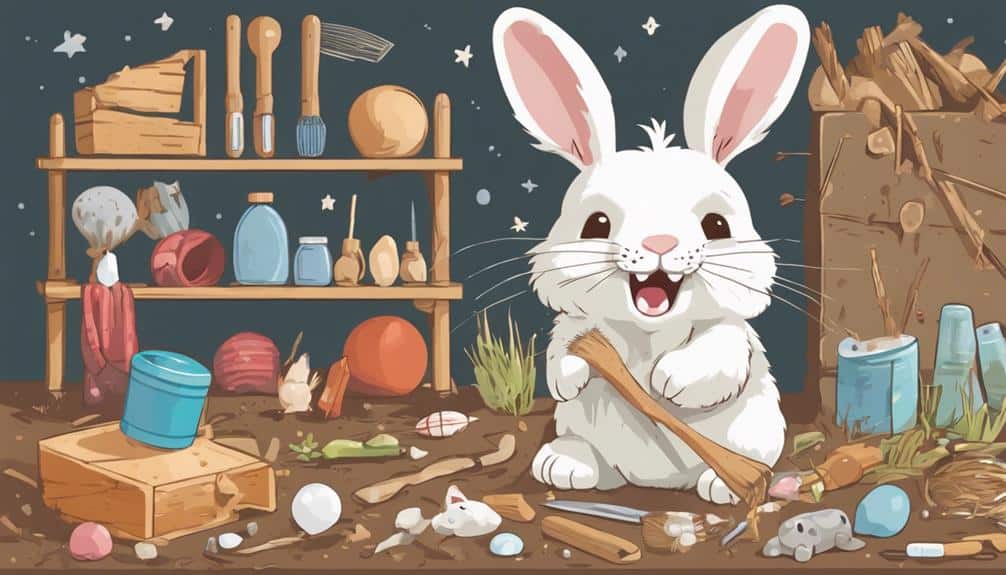
You've noticed your bunny grinding its teeth and wondering what it means. Understanding the causes behind this behavior is essential to your rabbit's health.
Let's explore the reasons for teeth grinding and its potential impact on your furry friend's well-being.
Causes of Grinding
Teeth grinding in rabbits serves as an important indicator of their overall well-being and shouldn't be overlooked, as it can signal various underlying causes. When observing this behavior, consider the following:
- Dental Health: Dental issues like overgrown teeth or malocclusion can lead to discomfort, prompting rabbits to grind their teeth.
- Contentment Signs: Soft, quiet teeth grinding is often a sign of contentment, indicating that your bunny is relaxed and happy.
- Stress Indicators: Loud and persistent teeth grinding may signify stress or pain, requiring closer attention and possible intervention.
- Environmental Factors: Changes in the rabbit's environment, diet, or social interactions can also trigger teeth grinding, highlighting the importance of a stable and enriching environment for your furry friend.
Impact on Health
Observing the frequency and intensity of teeth grinding in rabbits is essential for evaluating their overall well-being and identifying potential health issues. Teeth grinding can indicate various states in rabbits, from contentment to pain or illness. Monitoring this behavior closely can offer valuable insights into their dental hygiene, emotional well-being, and pain assessment. Regular veterinary check-ups play a vital role in detecting any underlying health problems that may manifest as abnormal teeth grinding. Providing a well-rounded care routine, including a balanced diet, proper dental hygiene, and a stress-free environment, can aid in preventing teeth grinding issues. Understanding the context and accompanying behaviors when a rabbit grinds its teeth is key to ensuring their overall health and happiness.
| Dental Hygiene | Emotional Well Being | Pain Assessment |
|---|---|---|
| Regular check-ups | Stress-free environment | Monitor behavior |
| Balanced diet | Behavioral observation | Veterinary care |
| Dental care routine | Social interaction | Address discomfort |
Circulating Behavior Around Humans
When observing Alaskan bunnies, their circling behavior around humans serves as a significant indicator of their affection and desire for bonding. This behavior is essential in understanding the bunny's need for social interaction and emotional connection with their human companions.
Here are some key points to help you grasp the significance of this circling behavior:
- Bonding Rituals: The circling behavior of Alaskan bunnies symbolizes a desire to form a stronger bond with their human through physical closeness.
- Seeking Attention: By moving in circular motions around you, the bunny is actively seeking your attention and interaction.
- Trust and Comfort: When an Alaskan bunny circles around you, it signifies a level of trust and comfort they've in your presence.
- Desire for Treats: Sometimes, circling behavior is a subtle request for treats or affection from their favorite humans.
Understanding and responding positively to this circling behavior can deepen the bond between you and your Alaskan bunny, fostering a harmonious relationship based on trust and mutual affection.
Playful Interactions and Nipping
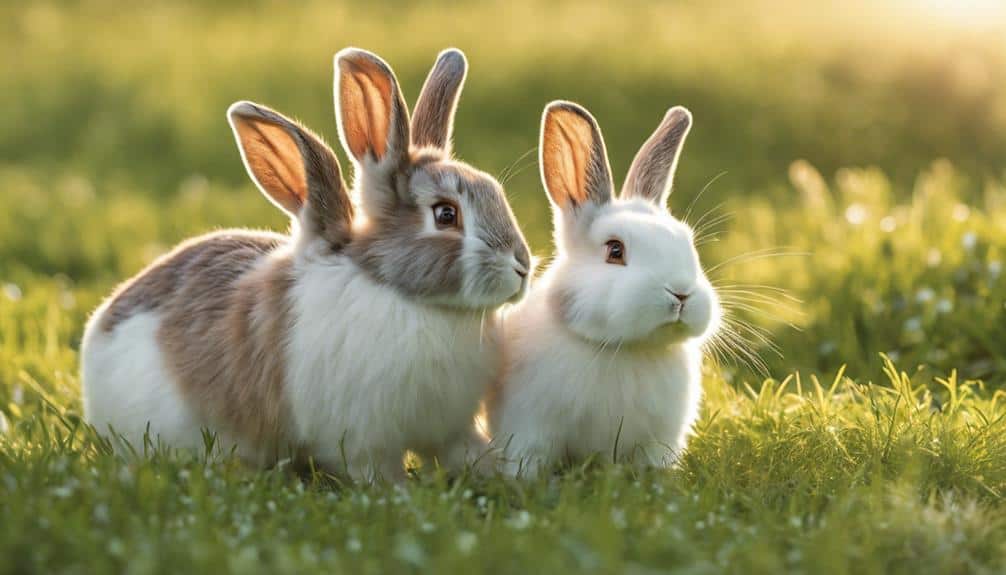
During engaging interactions with Alaskan bunnies, their nipping behavior serves as a means of communication and social engagement, often indicating excitement or affection. Bunnies may exhibit interactive nips as bonding signals, using them as a way to express their joy and strengthen their connection with you. These interactive games are not only enjoyable for the bunnies but also serve as communication cues, helping them establish social norms and boundaries. Understanding their binky antics and social cues can deepen your relationship with these furry friends. To provide a more immersive presentation, let's delve into a table showcasing some common behaviors and their meanings during playful interactions with Alaskan bunnies:
| Playful Behavior | Meaning |
|---|---|
| Gentle nipping | Affection or excitement |
| Binky antics | Joy and happiness |
| Tail flicking | Playfulness and fun |
| Licking | Bonding and grooming |
| Pawing at objects | Curiosity and exploration |
Territory Marking and Spraying Behaviors
Rabbits establish their territory by marking it with a mixture of urine and scent glands secretions, a behavior more commonly exhibited by unneutered or unspayed individuals to assert dominance. Hormonal changes play a significant role in these behaviors, especially in male rabbits as they reach sexual maturity.
Here are some observations and insights to help you understand and address territory marking and spraying behaviors in your pet bunny:
- Distinctive Scent Trails: Imagine your rabbit delicately spraying its unique blend around the room, creating invisible boundaries only they can decipher.
- Social Status Signaling: Visualize your unneutered male rabbit marking its territory more frequently, a natural response to hormonal shifts and the desire to establish dominance.
- Neutering Benefits: Picture the reduction in spraying behaviors post-neutering, a positive outcome that also promotes a more relaxed and content bunny.
- Engagement Strategies: Envision a harmonious environment enriched with ample space, toys, and social interactions, key elements that can help deter excessive spraying and territorial behaviors.
Are Alaskan Bunny Behavior Patterns Different from Common Bunny Behaviors?
Yes, the behavior patterns of Alaskan bunnies are different from common bunny behaviors habits. The extreme cold, scarcity of resources, and different predator threats in Alaska have resulted in unique behaviors in Alaskan bunnies. They have adapted to survive in their challenging environment, which sets them apart from common bunny behaviors.
Conclusion
As you observe the intricate behaviors of Alaskan bunnies, you can't help but see them as little furry dancers, hopping and twirling through their territories with grace and precision.
Just like ballerinas on stage, these bunnies mark their territory with deliberate chins and express themselves through vocalizations and playful interactions.
Remember, every hop, grunt, and nibble tells a story of their world, inviting you to dive deeper into the fascinating behaviors of these adorable creatures.

